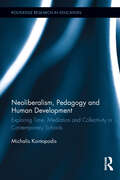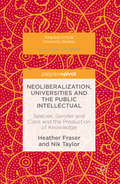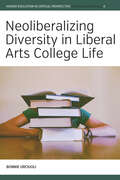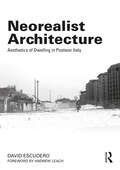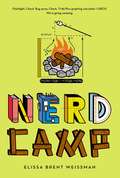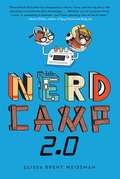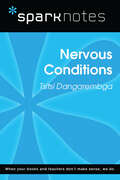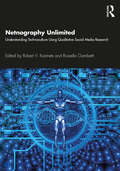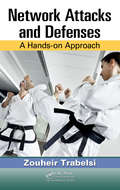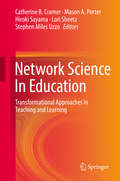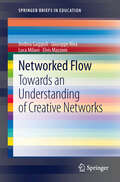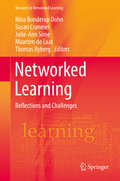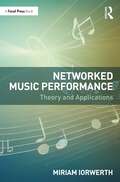- Table View
- List View
Neoliberalism, Pedagogy and Human Development: Exploring Time, Mediation and Collectivity in Contemporary Schools (Routledge Research in Education)
by Michalis KontopodisIn most Western developed countries, adult life is increasingly organized on the basis of short-term work contracts and reduced social security funds. In this context it seems that producing efficient job-seekers and employees becomes the main aim of educational programs for the next generation. Through case studies of young people from urban and countryside marginalized populations in Germany, USA and Brazil, this book investigates emerging educational practices and takes a critical stance towards what can be seen as neoliberal educational politics. It investigates how mediating devices such as CVs, school reports, school files, photos and narratives shape the ways in which those marginalized students reflect about their past as well as imagine their future. By building on process philosophy and time theory, post-structuralism, as well as on Vygotsky's psychological theory, the analysis differentiates between two discrete modes of human development: development of concrete skills (potential development) and development of new societal relations (virtual development, which is at the same time individual and collective). The book outlines an innovative relational account of learning and human development which can prove of particular importance for the education of marginalized students in today's globalized world.
Neoliberalization of English Language Policy in the Global South (Language Policy #29)
by Ali Jalalian Daghigh Jariah Mohd Jan Sheena KaurThis book investigates different ways in which neoliberal language and teaching policies have influenced the English language in global south countries across Asia, Africa and Latin America. Through the three main sub themes covered by the book, namely Neoliberalism and English Language Teaching Policies, Neoliberalism Ideology as in English Language Teaching Materials, and Experiences of Neoliberal Subjects, it investigates various aspects and means through which neoliberalism is realized in a variety of contexts.Through the first subtheme the volume covers the English language education policies of Chile, Bangladesh, India, and Morocco. The second sub theme concerns how different neoliberal values such as consumerism, entrepreneurship, and individualism are localized and constructed in the locally developed English language materials of Thailand, Taiwan, Malaysia, and Vietnam. The third sub theme includes studies on the impact of neoliberalization of English in relation to Colombian, Brazilian, and Pakistani stakeholders. This book is a valuable resource for academics, postgraduate students, researchers, policy makers, educators, and practitioners who are interested in neoliberalism in English language.
Neoliberalization, Universities and the Public Intellectual
by Heather Fraser Nik TaylorThis book employs an an intersectional feminist approach to highlight how research and teaching agendas are being skewed by commercialized, corporatized and commodified values and assumptions implicit in the neoliberalization of the academy. The authors combine 50 years of academic experience and focus on species, gender and class as they document the hazardous consequences of seeing people as instruments and knowledge as a form of capital. Personal-political examples are provided to illustrate some of the challenges but also opportunities facing activist scholars trying to resist neoliberalism. Heartfelt, frank, and unashamedly emotional, the book is a rallying cry for academics to defend their role as public intellectuals, to work together with communities, including those most negatively affected by neoliberalism and the corportatization of knowledge.
Neoliberalizing Diversity in Liberal Arts College Life (Higher Education in Critical Perspective: Practices and Policies #6)
by Bonnie UrciuoliAs neoliberalism has expanded from corporations to higher education, the notion of “diversity” is increasingly seen as the contribution of individuals to an organization. By focusing on one liberal arts college, author Bonnie Urciuoli shows how schools market themselves as “diverse” communities to which all members contribute. She explores how students of color are recruited, how their lives are institutionally organized, and how they provide the faces, numbers, and stories that represent schools as diverse. In doing so, she finds that unlike students’ routine experiences of racism or other social differences, neoliberal diversity is mainly about improving schools’ images.
Neorealist Architecture: Aesthetics of Dwelling in Postwar Italy
by David EscuderoAfter World War II, a wave of Italian films emerged that depicted the life and hardships of characters left helpless after the conflict, bringing to the screen the struggles of a time of existential angst and uncertainty. This form of filmmaking was associated with a broader artistic phenomenon known as ‘neorealism’ and is now considered a pivotal point in the history of Italian cinema. But neorealism was not limited to film any more than it was to literature. It spread to other areas of artistic production, including architecture. What was, then, neorealist architecture? This book explores the links between architecture, filmmaking and the built environment in dopoguerra Italy (194X–195X) seeking to ascertain whether, and how, neorealism manifested itself in architecture. Terms such as ‘neorealist architecture’ or ‘architectural neorealism’ were hinted at in these years and recalled by historians of architecture in the following decades. Therefore, the concept was adopted ad hoc and popularized post hoc, in the absence of any declarations prior to 1955 that proclaimed what neorealism in architecture was or wanted to be. However, while the concept has been internalized by Italian architectural history, transfers between neorealism—as an aesthetic and ethic—and architecture—as one potential medium of its embodiment or expression—are still not fully understood. Therefore, its main goal is to provide an in-depth discussion of the concept ‘neorealist architecture’, the working assumption being that the connection between both terms is not meaningless. The book is beautifully illustrated with over 100 black and white archival images and is the first book to be published on neorealism in architecture. It will appeal to scholars, professionals, and students interested in history and theory of architecture, Italian studies, art history, and cultural studies.
Nerd Camp
by Elissa Brent WeissmanPack your sleeping bag, grab your calculator, and celebrate geekdom with this humorous and empowering middle grade novel by the acclaimed author of Standing for Socks. Nerd Camp, here we come!Ten-year-old Gabe has just been accepted to the Summer Center for Gifted Enrichment. That means he'll be spending six weeks at sleepaway camp, writing poetry and perfecting logic proofs. S.C.G.E. has been a summer home to some legendary middle-school smarty-pants (and future Jeopardy! contestants), but it has a reputation for being, well, a Nerd Camp. S.C.G.E = Smart Camp for Geeks and Eggheads. But is Gabe really a geek? He's never thought about it much--but that was before he met Zack, his hip, LA-cool, soon-to-be stepbrother. Gabe worries that Zack will see him only as a nerd, until a wild summer at camp--complete with a midnight canoe ride to "Dead Man's Island"--helps Gabe realize that he and Zack have the foundations for a real friendship. This clever, fun read from Elissa Brent Weissman is full of great minor characters (like a bunkmate who solves math problems in his sleep) and silly subplots (like the geekiest lice outbreak ever). Adjust your head-gear, pack your camp bag, and get ready to geek out!
Nerd Camp
by Elissa Brent WeissmanPack your sleeping bag, grab your calculator, and celebrate geekdom with this humorous and empowering middle grade novel by the acclaimed author of Standing for Socks. Nerd Camp, here we come!Ten-year-old Gabe has just been accepted to the Summer Center for Gifted Enrichment. That means he'll be spending six weeks at sleepaway camp, writing poetry and perfecting logic proofs. S.C.G.E. has been a summer home to some legendary middle-school smarty-pants (and future Jeopardy! contestants), but it has a reputation for being, well, a Nerd Camp. S.C.G.E = Smart Camp for Geeks and Eggheads. But is Gabe really a geek? He's never thought about it much--but that was before he met Zack, his hip, LA-cool, soon-to-be stepbrother. Gabe worries that Zack will see him only as a nerd, until a wild summer at camp--complete with a midnight canoe ride to "Dead Man's Island"--helps Gabe realize that he and Zack have the foundations for a real friendship. This clever, fun read from Elissa Brent Weissman is full of great minor characters (like a bunkmate who solves math problems in his sleep) and silly subplots (like the geekiest lice outbreak ever). Adjust your head-gear, pack your camp bag, and get ready to geek out!
Nerd Camp
by Elissa Brent WeissmanTen-year-old Gabe has just been accepted to the Summer Center for Gifted Enrichment. That means he'll be spending six weeks at sleepaway camp, writing poetry and perfecting logic proofs. SCGE has been a summer home of some legendary middle-school smarty-pants (and future Jeopardy! contestants), but it also has a reputation for being, well, a nerd camp. Gabe isn't a nerd. Is he? He's never thought about it much, but compared to Zack, his hip, soon-to-be-stepbrother from LA, Gabe's not so sure where he falls on the cool scale. A wild summer at camp--complete with a midnight canoe ride to Dead Man's Island--helps Gabe realize that he and Zack may be different, but that doesn't mean they can't be brothers...and friends. eak ever). Adjust your head-gear, pack your camp bag and get ready to geek out!
Nerd Camp 2.0
by Drew Willis Elissa Brent WeissmanGabe's happily headed back to Nerd Camp--but can he handle a cool-kid invasion?For Gabe, the equation for ideal summer bliss equals six glorious weeks of vigorous learning immersion at the Summer Center for Gifted Enrichment--aka, Nerd Camp. Last year was amazing, and this summer will be even better. At least, that's what Gabe thinks until a new variable is introduced: Zack, Gabe's cool stepbrother, was supposed to attend a camp nearby, but in the aftermath of a recent wildfire, Zack's camp and nerd camp will be sharing territory. As these two very different worlds collide, will both camps--and both stepbrothers--survive the summer?
Nervous Conditions (SparkNotes Literature Guide Series)
by SparkNotesNervous Conditions (SparkNotes Literature Guide) by Tsitsi Dangarembga Making the reading experience fun! Created by Harvard students for students everywhere, SparkNotes is a new breed of study guide: smarter, better, faster. Geared to what today's students need to know, SparkNotes provides: *Chapter-by-chapter analysis *Explanations of key themes, motifs, and symbols *A review quiz and essay topicsLively and accessible, these guides are perfect for late-night studying and writing papers
Nervous Norman Hot on the Trail: The Parable of the Lost Sheep (The Bug Parables)
by Bill Myers Andy J. SmithThe Bug Parables series brings Jesus’ teachings to life. Children will love the colorful illustrations and humorous, touching stories. And parents will love how little ones learn the principles of God’s Word at an early age. Nervous Norman Hot on the Trail With so many critters he must oversee, why would God care for just one lowly me? Baby Missy is missing! Hungry birds, nasty spiders … terrible things can happen to a lost little ladybug. Leaving his herd, Norman, the shepherd of ladybugs, heads off on a perilous search for Missy—and learns an important lesson about God’s love and care.
Netnography Unlimited: Understanding Technoculture using Qualitative Social Media Research
by Robert V. KozinetsNetnography has become an essential tool for qualitative research in the dynamic, complex, and conflicted worlds of contemporary technoculture. Shaped by academic fields, industries, national contexts, technologies and platforms, and languages and cultures for over two decades, netnography has impacted the research practices of scholars around the world. In this volume, 34 researchers present 19 chapters that examine how they have adapted netnography and what those changes can teach us. Positioned for students and researchers in academic and professional fields, this book examines how we can better use netnographic research to understand the many ways networked technologies affect every element of contemporary business life and consumer existence. Netnography Unlimited provides an unprecedented new look at netnography. From COVID-19 to influencer empathy, gambling and the Dark Web to public relations and the military, AI and more-than-human netnography to video-streaming and auto-netnography, there has never been a wider or deeper treatment of technocultural netnographic research in one volume. Readers will learn what kind of work they can do with netnography and gain an up-to-date understanding of the most pressing issues and opportunities. This book is a must-read for those interested in technology, research methods, and contemporary culture.
Netter's Essential Histology: With Correlated Histopathology (Netter Basic Science Series)
by William K. Ovalle Patrick C. NahirneyWith strong correlations between gross anatomy and the microanatomy of structures, Netter’s Essential Histology, 3rd Edition, is the perfect text for today’s evolving medical education. Concise and easy to use, it integrates gross anatomy and embryology with classic histology slides and state-of-the-art scanning electron microscopy, offering a clear, visual understanding of this complex subject. Additional histopathology images, more clinical boxes, and new histopathology content ensure that this textbook-atlas clearly presents the most indispensable histologic concepts and their clinical relevance. <p>• Helps you recognize both normal and diseased structures at the microscopic level with the aid of succinct explanatory text as well as numerous clinical boxes. <p>• Features more histopathology content and additional clinical boxes to increase your knowledge of pathophysiology and clinical relevance. <p>• Includes high-quality light and electron micrographs, including enhanced and colorized electron micrographs that show ultra-structures in 3D, side by side with classic Netter illustrations that link your knowledge of anatomy and cell biology to what is seen in the micrographs. <p>• Provides online access to author-narrated video overviews of each chapter, plus Zoomify images and Virtual Slides that include histopathology and can be viewed at different magnifications. <p>• Enhanced eBook version included with purchase. Your enhanced eBook allows you to access all of the text, figures, and references from the book on a variety of devices.
Network Attacks and Defenses: A Hands-on Approach
by Zouheir Trabelsi Kadhim Hayawi Arwa Al Braiki Sujith Samuel MathewThe attacks on computers and business networks are growing daily, and the need for security professionals who understand how malfeasants perform attacks and compromise networks is a growing requirement to counter the threat. Network security education generally lacks appropriate textbooks with detailed, hands-on exercises that include both offensive and defensive techniques. Using step-by-step processes to build and generate attacks using offensive techniques, Network Attacks and Defenses: A Hands-on Approach enables students to implement appropriate network security solutions within a laboratory environment. Topics covered in the labs include: Content Addressable Memory (CAM) table poisoning attacks on network switches Address Resolution Protocol (ARP) cache poisoning attacks The detection and prevention of abnormal ARP traffic Network traffic sniffing and the detection of Network Interface Cards (NICs) running in promiscuous mode Internet Protocol-Based Denial-of-Service (IP-based DoS) attacks Reconnaissance traffic Network traffic filtering and inspection Common mechanisms used for router security and device hardening Internet Protocol Security Virtual Private Network (IPsec VPN) security solution protocols, standards, types, and deployments Remote Access IPsec VPN security solution architecture and its design, components, architecture, and implementations These practical exercises go beyond theory to allow students to better anatomize and elaborate offensive and defensive techniques. Educators can use the model scenarios described in this book to design and implement innovative hands-on security exercises. Students who master the techniques in this book will be well armed to counter a broad range of network security threats.
Network Governance in Education: Lessons from School Turnaround in China
by Yuan TaoThis book explores and theorizes the complexity of network governance in school turnaround in China, drawing on an interpretive qualitative paradigm.School turnaround provides a useful perspective for understanding network governance in education, as it involves interactions among multiple parties of actors all aiming to improve school quality. Based on a case study of three school turnaround networks in Shanghai, this book analyzes the complexity of interactions among schools, local governments, and third-party actors. The study goes beyond a simple description of the plurality of state and non-state actors involved in education. It places particular emphasis on the power of network actors and the power dynamics among them that shape their interactions and positions in educational governance. The power perspective adopted in this book provides insight into which network actors matter in education governance and how network governance should be applied in education, particularly in school turnaround.The book will appeal to scholars and students of education and will be particularly useful to policymakers and practitioners interested in educational administration, management and leadership, educational improvement, and Chinese education.
Network Science In Education: Transformational Approaches in Teaching and Learning
by Mason A. Porter Hiroki Sayama Catherine B. Cramer Lori Sheetz Stephen Miles UzzoAround the globe, there is an increasingly urgent need to provide opportunities for learners to embrace complexity; to develop the many skills and habits of mind that are relevant to today's complex and interconnected world; and to make learning more connected to our rapidly changing workplace and society. This presents an opportunity to (1) leverage new paradigms for understanding the structure and function of teaching and learning communities, and (2) to promote new approaches to developing methods, curricular materials, and resources. Network science - the study of connectivity - can play an important role in these activities, both as an important subject in teaching and learning and as a way to develop interconnected curricula. Since 2010, an international community of network science researchers and educators has come together to raise the global level of network literacy by applying ideas from network science to teaching and learning. Network Science in Education - which refers to both this community and to its activities - has evolved in response to the escalating activity in the field of network science and the need for people to be able to access the field through education channels. Network Science In Education: Transformational Approaches in Teaching and Learning appeals to both instructors and professionals, while offering case studies from a wide variety of activities that have been developed around the globe: the creation of entirely new courses and degree programs; tools for K-20 learners, teachers, and the general public; and in-depth analysis of selected programs. As network-based pedagogy and the community of practice continues to grow, we hope that the book's readers will join this vibrant network education community to build on these nascent ideas and help deepen the understanding of networks for all learners.
Network Science, A Decade Later: The Internet and Classroom Learning
by Alan Feldman Cliff Konold Bob Coulter Brian ConroyNetwork Science, A Decade Later--the result of NSF-funded research that looked at the experiences of a set of science projects which use the Internet--offers an understanding of how the Internet can be used effectively by science teachers and students to support inquiry-based teaching and learning. The book emphasizes theoretical and critical perspectives and is intended to raise questions about the goals of education and the ways that technology helps reach those goals and ways that it cannot. The theoretical perspective of inquiry-based teaching and learning in which the book is grounded is consistent with the current discipline-based curriculum standards and frameworks. The chapters in Part I, "State of the Art," describe the history and current practice of network science. Those in Part II, "Looking Deeply," extend the inquiry into network science by examining discourse and data in depth, using both empirical data and theoretical perspectives. In Part III, "Looking Forward," the authors step back from the issues of network science to take a broader view, focusing on the question: How should the Internet be used--and not used--to support student learning? The book concludes with a reminder that technology will not replace teachers. Rather, the power of new technologies to give students both an overwhelming access to resources--experts, peers, teachers, texts, images, and data--and the opportunity to pursue questions of their own design, increases the need for highly skilled teachers and forward-looking administrators. This is a book for them, and for all educators, policymakers, students involved in science and technology education. For more information about the authors, an archived discussions space, a few chapters that can be downloaded as PDF files, and ordering information, visit teaparty.terc.edu/book/
Network+ Guide to Networks (5th edition)
by Tamara DeanThis book introduces the fundamental building blocks that form a modern network, such as protocols, topologies, hardware, and network operating systems. It then provides in-depth coverage of the most important concepts in contemporary networking, such as TCP/IP, Ethernet, wireless transmission, and security.
Network+ Guide to Networks 6th Edition
by Tamara DeanThe completely updated NETWORK+ GUIDE TO NETWORKS, 6th Edition gives readers the technical skills and industry know-how required to begin an exciting career installing, configuring, and troubleshooting computer networks. The text also prepares readers for CompTIA's Network+ N10-005 certification exam with fundamentals in protocols, topologies, hardware, and network design. After exploring TCP/IP, Ethernet, wireless transmission, and security concepts, as well as an all-new chapter on virtual networks, readers can increase their knowledge with the practical "On-the Job" stories, Review Questions, Hands-On Projects, and Case Projects
Networked By Design: Interventions for Teachers to Develop Social Capital
by Susan A. Yoon Kira J. Baker-DoyleNetworked by Design brings together work from leading international scholars in the learning sciences that applies social network theory to teachers’ social interactions and relationships. The volume examines the direct and indirect relationships and communities that teachers navigate, as well as the models, plans, and other interventions that allow them to exercise control over these networks. Each chapter draws from case studies or latitudinal research to investigate a different intervention and its outcomes. By presenting research conducted in a variety of scales and contexts, this book offers scholars, future teachers, and leaders diverse insights into how interventions in social capital and social networks can create impactful, meaningful teaching and learning.
Networked Flow
by Luca Milani Giuseppe Riva Elvis Mazzoni Andrea GaggioliIdentifying 'networked flow' as the key driver of networked creativity, this new volume in the Springer Briefs series deploys concepts from a range of sub-disciplines in psychology to suggest ways of optimizing the innovative potential of creative networks. In their analysis of how to support these networks, the contributing authors apply expertise in experimental, social, cultural and educational psychology. They show how developing a creative network requires the establishment of an optimal group experience in which individual intentions inform and guide collective goals. The volume represents a three-fold achievement. It develops a ground-breaking new perspective on group creativity: the notion of 'networked flow' as a bridging concept linking the neuropsychological, psychological and social levels of the creative process. In addition, the authors set out a six-stage model that provides researchers with a methodological framework (also by referring to the social network analysis) for studying the creativity traditionally associated with interpersonal contexts. Finally, the book includes perceptive analysis of the novel possibilities opened up by second-generation internet technologies, particularly in social networking, that seem destined to develop and sustain online creativity. As a wide-ranging exposition of a new direction in theoretical psychology that is laden with exciting possibilities, this volume will inform and inspire professionals, scholars and students alike.
Networked Learning
by Christopher JonesThis book posits the idea that networked learning is the one new paradigm in learning theory that has resulted from the introduction of digital and networked technologies It sets out, in a single volume, a critical review of the main ideas and then articulates the case for adopting a networked learning perspective in a variety of educational settings. This book fills a gap in the literature on networked learning Although there are several edited volumes in the field there is no other monograph makes the academic case and provides the academic context for networked learning. This volume accomplishes three main goals. First, it assists researchers and practitioners in acquainting themselves with the field. Second, it provides resources for reference and guidance to those not well acquainted with the field Finally and most powerfully, it also allows for the consolidation of a field that is truly multidisciplinary in a way that maintains coherence and consistency.
Networked Learning: Reflections And Challenges (Research in Networked Learning)
by Thomas Ryberg Maarten De Laat Nina Bonderup Dohn Susan Cranmer Julie-Ann SimeThe book is based on nine selected, peer-reviewed papers presented at the 10th biennial Networked Learning Conference (NLC) 2016 held in Lancaster. Informed by suggestions from delegates, the nine papers have been chosen by the editors (who were the Chairs of the Conference) as exemplars of cutting edge research on networked learning. Further reviews of all papers were conducted once they were revised as chapters for the book. The chapters are organized into two sections: 1) Situating Networked Learning: Looking Back - Moving Forward, 2) New Challenges: Designs for Networked Learning in the Public Arena. Further, we include an introduction which looks at the evolution of trends in Networked Learning through a semantic analysis of conference papers from the 10 conferences. A final chapter draws out perspectives from the chapters and discusses emerging issues. The book is the fifth in the Networked Learning Conference Series.
Networked Music Performance: Theory and Applications
by Miriam IorwerthNetworked Music Performance (NMP) is the essential guide to both playing music online and ensemble music through networks. Offering a range of case studies, from highly technical solutions to inclusive community projects, this book provides inspiration to musicians to try NMP whatever their level of technical expertise. Drawing upon recent research to examine the background and history of the practice as well as specific practical approaches, technical and musical considerations are included for readers, as are ideas around accessibility and creativity. Accessibility is considered in the context of the opportunities that NMP gives to musicians working remotely, as well as some of the barriers to participation in NMP and how these can be overcome. Synchronous and asynchronous approaches to NMP are explored in detail, examining the technical and musical affordances and challenges of working remotely for musicians. Networked Music Performance will appeal to music and music technology students as well as professional musicians and technicians who have started working online and wish to improve their practice. As NMP in the context of music education and community music are also explored, this book supplies educators and community leaders with knowledge and practical guidance on how to move their practice online.
Networked Professional Learning: Emerging and Equitable Discourses for Professional Development (Research in Networked Learning)
by Allison Littlejohn Jimmy Jaldemark Emmy Vrieling-Teunter Femke NijlandOver the past decades a new form of professionalism has emerged, characterized by factors of fluidity, instability and continual change, leading to the necessitation of new forms of professional development that support agile and flexible expansion of professional practice. At the same time, the digitization of work has had a profound effect on professional practice. This digitization opens up opportunities for new forms of professional learning mediated by technologies through networked learning. Networked learning is believed to lead to a more efficient flow of complex knowledge and routine information within the organization, stimulate innovative behaviour, and result in a higher job satisfaction. In this respect, networked learning can be perceived as an important perspective on both professional and organizational development. This volume provides examples of Networked Professional Learning, it questions the impact of this emerging form of learning on the academy, and it interrogates the impact on teachers of the future. It features three sections that explore networked professional learning from different perspectives: questioning what legitimate forms of networked professional learning are across a broad sampling of professions, how new forms of professional learning impact institutions of higher education, and the value creation that Networked Learning offers professionals in broader educational, economic, and social contexts. The book is of interest to researchers in the area of professional and digital learning, higher education managers, organizational HR professionals, policy makers and students of technology enhanced learning.
